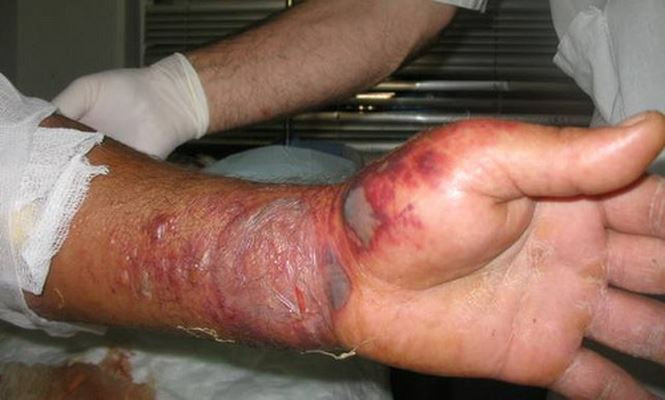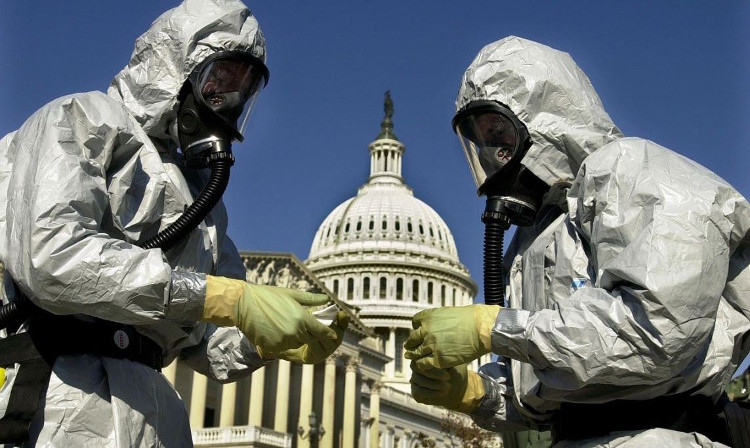Anthrax bacteria - scary biological weapons!
n has the ability to cause high mortality, survive in harsh environments, turn it into a dangerous biological weapon.
What is anthrax?

Long rod-shaped anthrax bacteria.(Photo: Live Science).
Anthrax (Anthrax) is an acute infectious disease caused by Bacillus anthracis on warm-blooded animals, including cattle, wildlife and humans. A pandemic of anthrax has happened many times, mainly affecting farmers, who often have contact with infected animals.
The most common form of infection in humans is through skin contact, when anthrax spores enter the body at open wounds. This is also the easiest to treat, the patient will completely recover after treatment with antibiotics.
The US National Library of Medicine says anthrax bacteria are most dangerous when they reach the respiratory tract, often on workers handling fur and fur. Bacterial spores often enter the alveoli in the lungs and are destroyed by the immune system, but some spores can penetrate the lymph nodes, develop into bacteria and spread toxins that destroy cells.
If the patient is left untreated, the toxin will build up in the lungs, causing serious problems. The victim will experience flu-like symptoms and colds for several days, then switch to complications of pneumonia, respiratory failure, hypotension, meningitis and organ failure.

Symptoms of anthrax on human skin.(Photo: AAP).
The death rate of this form of anthrax can be up to 92%. However, it is also the most difficult form. A person must inhale 8,000-10,000 newly infected spores, and they must penetrate deep into the lungs before causing harm.
The last form is anthrax in the gastrointestinal tract, which occurs when the victim eats the flesh of an infected animal. Germs usually take one to 60 days to develop, causing fever, cough, chills, nausea and vomiting. This is the rarest form in the United States, often with a mortality rate of 20-60%, can be completely cured with antibiotics if detected early.
danger
However, when used for military purposes, anthrax becomes one of the world's most dangerous biological weapons, according to former Assistant Secretary of Defense Andrew Weber.
Anthrax bacteria can easily be grown in a laboratory, and have a high viability. They can sleep for years before invading the host, re-activating and reproducing. A small amount of nail bacteria is also capable of killing more than 10,000 people.
During World War I, Nordic countries used anthrax to attack Russian Tsar forces. It also reappeared when British forces tried to destroy the large Nazi herds during World War II.

Anthrax was used in the 2001 US terrorist attack. (Photo: NTI).
In 1993, a Japanese religious group spread anthrax bacteria in the public area in Tokyo, but did not cause casualties. Just eight years later, a series of letters containing anthrax spores were sent to media offices and two US senators, killing five people and 17 infected.
The anthrax treatment vaccine has been developed since 1881, helping to minimize the number of people infected and killed by natural causes.
Although anthrax spores can survive for a long time, they cannot survive for more than 30 minutes in boiling water or 5 minutes under irons. This is an effective way to kill anthrax bacteria in common items.
- America's top secret biochemical weapons testing facility
- Early detection device for coal
- How were biological weapons born?
- Tested to prove that the spray anthrax vaccine is highly effective
- The dead island is suspected to be a test site for Soviet biological weapons
- Biological history and risk of Ebola
- From the Lego toy model: There is an effective remedy for anthrax
- Preparation of vaccine for smallpox and anthrax
- New weapons help kill drug-resistant bacteria
- Bioterrorism Detector
- Forget sharks, these 5 bacteria also make you
- 10 scary weapons and tactics in ancient war
 'Fine laughs' - Scary and painful torture in ancient times
'Fine laughs' - Scary and painful torture in ancient times The sequence of numbers 142857 of the Egyptian pyramids is known as the strangest number in the world - Why?
The sequence of numbers 142857 of the Egyptian pyramids is known as the strangest number in the world - Why? History of the iron
History of the iron What is alum?
What is alum?